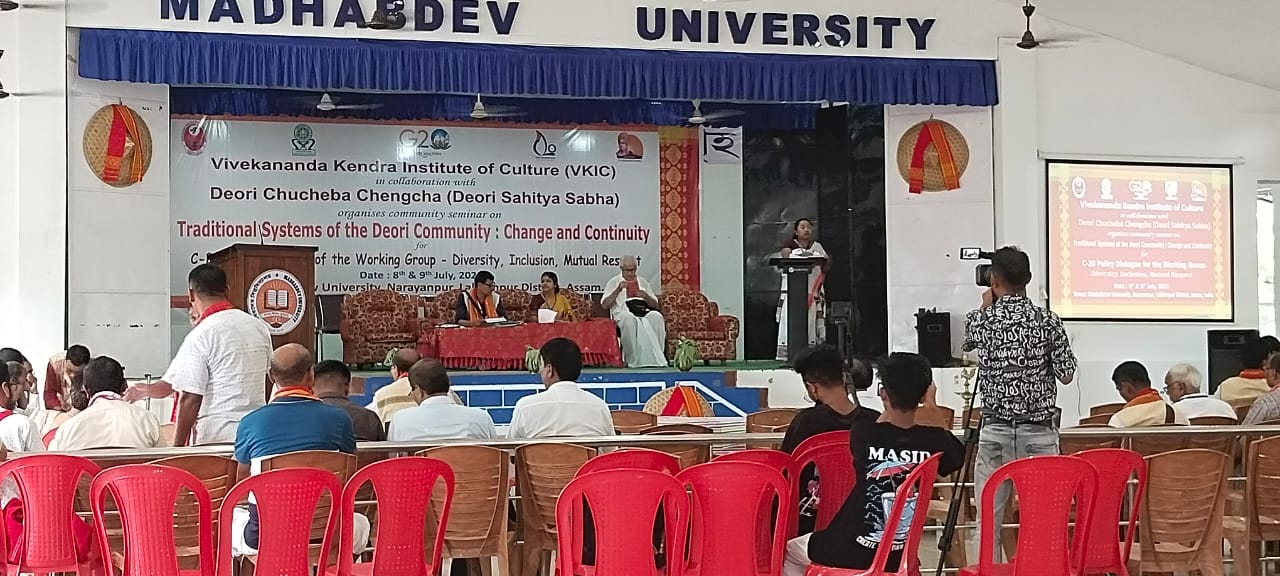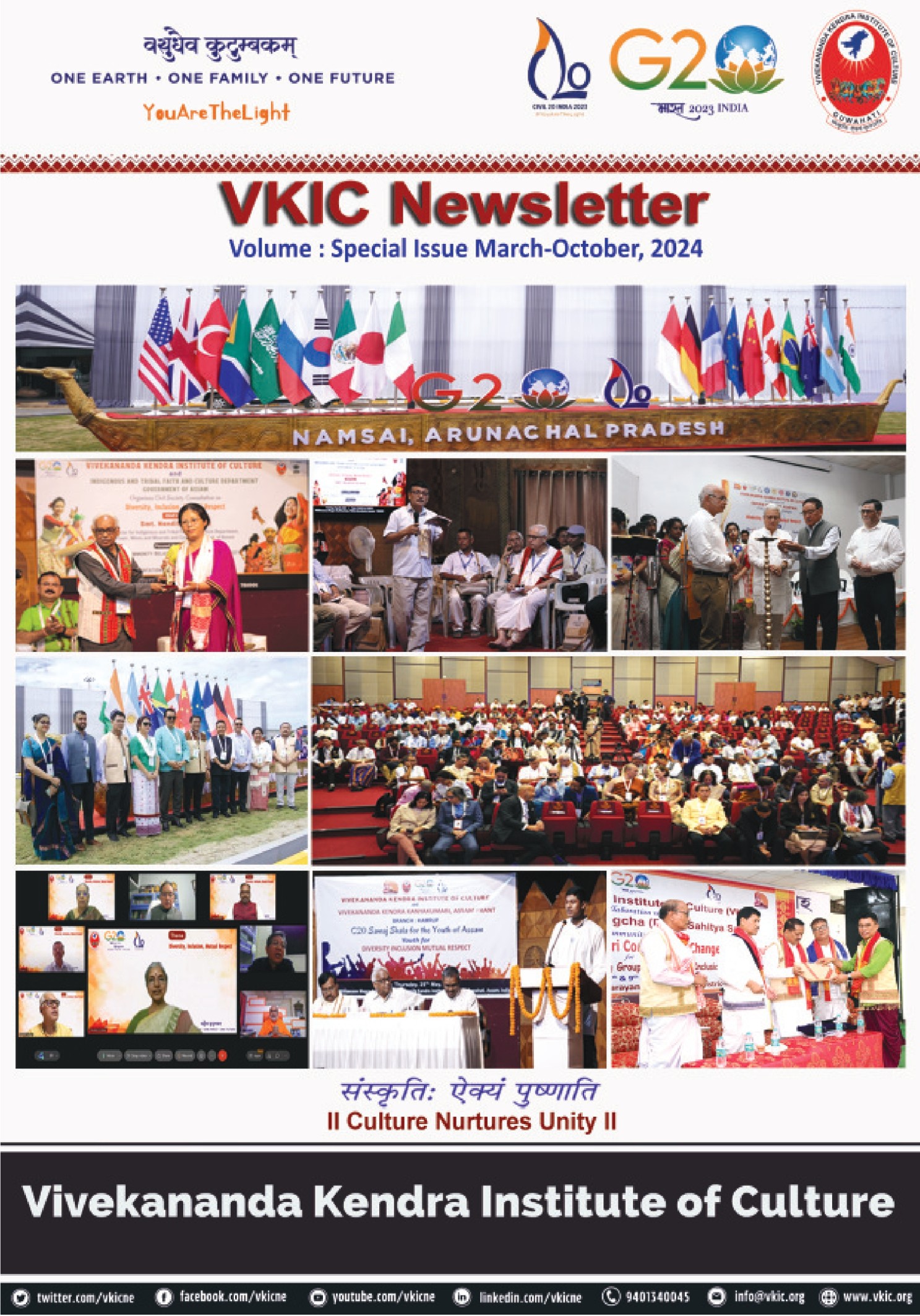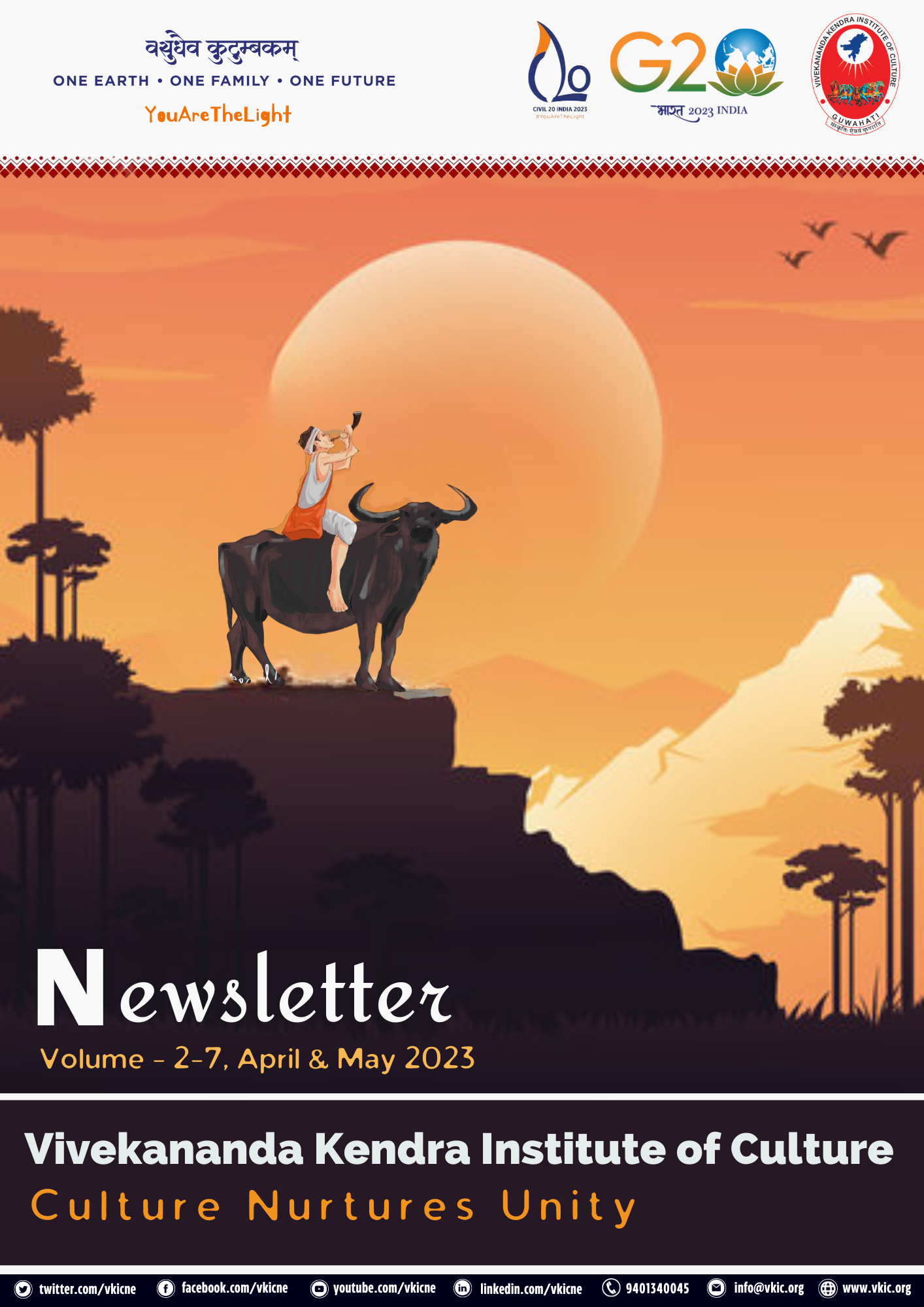Community Seminar - Traditional Systems of The Deori Community: Change and Continuity
Date - 8th- 9th July 2023 Organizers -Vivekananda Kendra Institute of Culture, Deori Chucheba,Chengcha Venue -Madhabdev University, Narayanpur District, Assam, India Participants -152
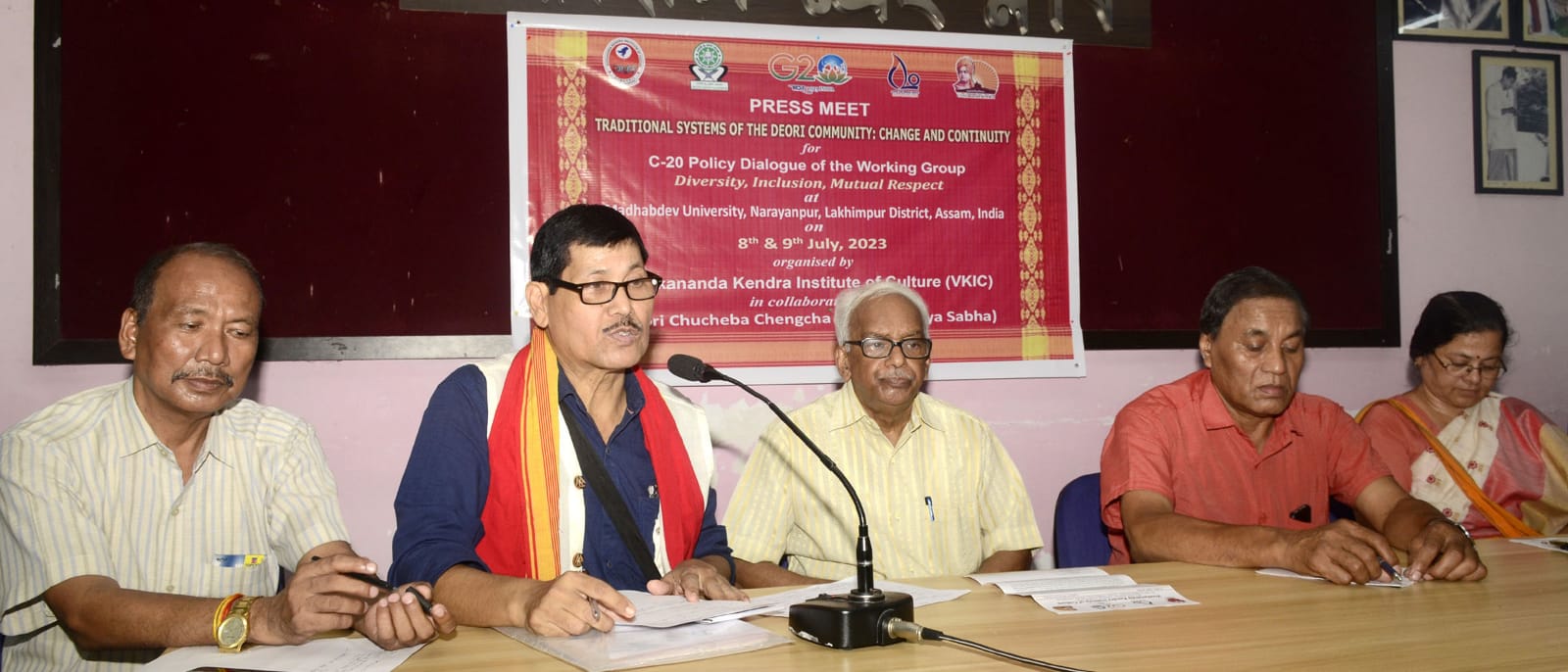 Important Dignitaries - Dr Amiya Kumar Bhuyan, MLA Bhipuria Constituency, Lakhimpur District, Assam, India, Prof. Nirode Boruah ,. Hon'ble Vice Chancellor, Madhabdev University, Shri Anand Mishra, Superintendent of Police, North Lakhimpur District, Assam, India, Dr Joram Begi, National Coordinator, DIMR and Chairman VKIC, Shri Bhoirab Deori, Chief Executive Member Deori Autonomous Council.
Important Dignitaries - Dr Amiya Kumar Bhuyan, MLA Bhipuria Constituency, Lakhimpur District, Assam, India, Prof. Nirode Boruah ,. Hon'ble Vice Chancellor, Madhabdev University, Shri Anand Mishra, Superintendent of Police, North Lakhimpur District, Assam, India, Dr Joram Begi, National Coordinator, DIMR and Chairman VKIC, Shri Bhoirab Deori, Chief Executive Member Deori Autonomous Council.
Purpose of the Event
The nature and purpose of the community seminar is a participatory and interactive platform. The key aspects of this seminar include:
- Community Focus: The seminar is cantered around diverse communities, recognizing the value and significance of their traditions, culture, and rituals. This focus indicates an intention to celebrate and learn from the rich diversity that exists within these communities.
- Participatory Approach: The seminar is designed to actively involve participants, encouraging them to share their insights, experiences, and practices. This approach promotes a dynamic exchange of ideas and fosters collaborative learning.
- Learning and Innovation: By engaging with various communities, the seminar aims to gather knowledge about their best practices. This understanding serves as a foundation for innovation and improvement across different aspects of the society.
- Enhancing Sustainability: The focus on sustainable action suggests that the seminar aims to identify practices and approaches that can be maintained over time for the benefit of both the communities and society at large.
- Cultural Exchange: The emphasis on learning from different communities indicates an interest in cultural exchange and cross-cultural understanding. This can contribute to mutual respect and appreciation among participants from various backgrounds.
- Promoting Diversity and Inclusion: By acknowledging and highlighting diverse traditions and practices, the seminar aligns with the values of diversity, inclusion, and mutual respect.
- Action-Oriented: The mention of "sustain action" indicates that the insights gained from the seminar will not just remain theoretical but will be applied in practical ways to bring about positive change.
The seminar also focused on "community knowledge and indigenous wisdom for sustaining diversity, modernity and creating a conflict-free world" besides embodying a holistic and inclusive approach to progress. This approach is further emphasized through the theme of "Enhancing Development through Culture," which recognizes the profound impact that culture has on shaping societies and economies.
Key elements include
- Community Knowledge and Indigenous Wisdom: By valuing and integrating community knowledge and indigenous wisdom, the seminar acknowledges the importance of preserving and drawing from the accumulated wisdom of various cultures. This knowledge can offer unique insights into sustainable practices and harmonious coexistence.
- Sustaining Diversity: The emphasis on sustaining diversity indicates a commitment to preserving cultural heritage and recognizing its importance in enriching societies. This aligns with the idea that diverse perspectives and traditions contribute to a more vibrant and resilient world.
- Modernity and Conflict-Free World: The recognition of indigenous wisdom alongside modernity implies a balanced approach that seeks to integrate traditional wisdom with contemporary advancements. This integration can contribute to resolving conflicts and promoting harmony in a rapidly changing world.
- Enhancing Development through Culture: Culture is acknowledged as a driving force for development, going beyond economic factors. This perspective aligns with the notion that culture is not just a backdrop but a cornerstone of progress.
- Unique Economy Dynamics: The mention of "unique economy dynamics" suggests an understanding that economic practices can vary across cultures and contexts. This recognition supports the idea that tailored approaches are essential for addressing specific challenges and opportunities.
- One Size Doesn't Fit All: The principle of "One size doesn't fit all" underscores the importance of context-specific solutions. This principle challenges the notion of uniform solutions and instead advocates for strategies that respect individuality and diversity.
Thus the community seminar aims to bridge the gap between traditional wisdom and modern advancements, leveraging culture and community knowledge to create a harmonious and conflict-free world. It seeks to strike a balance between progress and preservation, while acknowledging the need for context-specific strategies that honour diversity and uniqueness. Overall, the seminar seeks to create a space for inclusive dialogue shared learning and the exchange of ideas among diverse communities with the ultimate goal of fostering innovation and sustainable action.
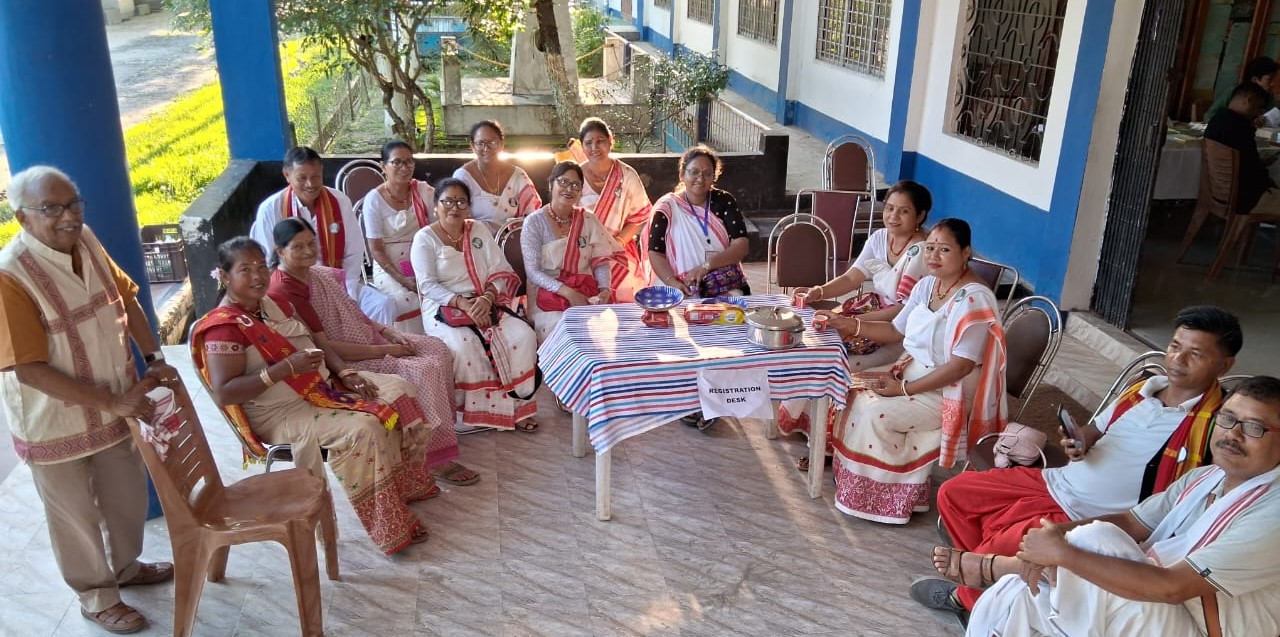
Deori Community: An Introduction
Below are the insights into the Deori community, one of the major indigenous groups in the Northeast region of India. Few key points of the seminar:
- Origin and Identity: The Deoris originate from the Chutiya community and are considered to be descendants of King Bhismaka. The term "Deori" signifies individuals with deep knowledge of gods and goddesses, often referred to as the Brahmins of the indigenous tribes. They settled in regions like Kundil (Sadiya) along the Kundilpani river.
- Colonial Era and Racial Theories: During the colonial period, racial theories were propagated to create feelings of discontent and inferiority among indigenous communities. These theories aimed to justify foreign invasions. The Deori community was also influenced by these narratives, which falsely linked their origins to North East Asia.
- Religious Beliefs: The Deori community practices a complex system of worship involving various gods and goddesses. Deities like Kundi-Mama, Burha Burhi (Siva-Durga), and Pisa-dema (Siva) hold significance in their religious practices. Historical accounts suggest that the Deoris served as royal priests for Chutiyas, Kacharies, and Ahoms.
- Migration and Environmental Factors: Due to factors such as natural disasters (e.g., the 1950 earthquake and floods), the Deoris migrated from their original homeland of Sadiya to different districts of Assam. British historians theorized invasions as the reason behind migration, although these theories lacked substantial evidence and have been discredited by academia.
- Population and Literacy: The Deori population is smaller compared to other indigenous groups in the region, constituting around 1.20% of the total janajati population of Assam. The literacy rate has shown improvement over the years, rising from 27.73% in 1971 to 54.13% in 1991.
- Challenges and Cultural Preservation: The passage indicates challenges faced by the Deori community, including linguistic shifts and the potential loss of the Deori language among the youth. It also highlights efforts to preserve and understand their unique culture, including countering distorted historical narratives.
Overall, the passage sheds light on the Deori community's history, cultural practices, challenges, and efforts to maintain their identity and heritage in the face of various external influences and modern developments.
Community Uniqueness
Every community around the world possesses a unique set of traditions, culture, practices and values that play a crucial role in preserving their identity and heritage. Below is an in-depth look into various aspects of the Deori community, shedding light on their traditions, culture and way of life.
- Community Diversity: The Deori community can be categorized into three groups: Dibongiyas, Tengaponiyas, and Borgoyans.
- Language: While Dibongiyas retain their language, the other two groups have adopted Assamese.
- Deities' Influence: The Deori society is influenced by the commands of deities, known as Deodhoni , who play a significant role in guiding the community.
- Deori Gods: Prominent deities in Deori worship include Kundi Mama, Burha-Burhi (Siva-Durga), and Baliya Baba.
- Main source of livelihood: Agriculture and domestication of animals remains the primary source of livelihood for the Deori community.
- Changing Occupations: Modern-day youth are increasingly shifting away from traditional sources of income. For instance, many in Bordeorigaon have joined the Indian Army to serve the motherland.
- Self-Reliance and Community Support: The Deoris exhibit a strong sense of self-reliance and community support. During economic crises, the community comes together to contribute and support affected families.
- Housing and Lifestyle: Deori houses are constructed using bamboo and cane thatch, elevated about 5-7 ft from the ground. Features like Misong (open space), granaries, and weaving units are common.
- Judicial System: The Deori community upholds traditional judicial systems rooted in faith and community values. Elders, guided by deori gods, make decisions, contributing to a crime-free society.
- Education: Traditional education is imparted orally in Thaangarhs and Dewalayas (temples) by Pujaris through Diksha (initiation). However, modern education is becoming more preferred by parents.
- Health and Healing: Traditional healing systems are practiced by healers known as Mongolotis , based on faith in deities and community gods.
- Distinctive Dress: The Deori community follows strict distinctions in dress between married and unmarried women, with various cloth types and styles.
- Major Festival: Bisu Puja is a significant festival in Deori culture.
- Dietary Habits: The staple diet consists of rice, and meat, fish, and pork are commonly consumed. Dishes like Miduji Jubura (Bamboo shoot curry) and Chucha (Dry fish chutney) are popular.
This detailed overview offers insights into the Deori community's rich cultural practices, socio-economic dynamics, and traditional values that continue to shape their way of life.
Recommendations
Right to culture-The idea of a "Right to Culture" generally refers to the recognition and protection of an individual's or a community's right to practice, preserve, and express their cultural identity. This includes aspects such as language, culture, traditions, arts, and customs. Advocates argue that acknowledging and protecting cultural rights can foster a sense of belonging, strengthen social cohesion, and contribute to the overall well-being of individuals and communities. Some excepts of the discussion are given below:
- Preservation of Identity: Unique traditions and cultural practices help communities maintain their distinct identity in a rapidly changing world. These elements connect present generations to their past and provide a sense of continuity.
- Cohesion and Unity: Shared traditions and practices create a sense of belonging and unity among community members. They strengthen interpersonal bonds and promote social cohesion.
- Resilience and Adaptation: Cultural practices often hold inherent wisdom that has been accumulated over generations. They provide communities with tools to adapt to challenges and changes, enabling them to thrive in various circumstances.
- Transmission of Values: Traditions and cultural practices are effective vehicles for transmitting values, ethics, and morals from one generation to the next. They teach lessons about respect, cooperation, and community responsibility.
- Addressing Challenges: Communities often embed solutions to local challenges within their traditions. Traditional knowledge and practices can offer insights into sustainable resource management, healthcare, conflict resolution, and more.
- Cultural Diversity: The diversity of cultures globally enriches humanity's collective experience. By preserving their unique practices, communities contribute to the global tapestry of cultures, fostering mutual respect and understanding.
- Empowerment and Pride: Embracing and celebrating one's cultural heritage fosters a sense of pride and self-esteem. It empowers individuals to express their identity confidently in the broader society.
- Innovation: Unique cultural elements can inspire innovation. By drawing from traditional knowledge and practices, communities may develop creative solutions to modern challenges.
- Interconnectedness: Cultural practices often tie communities to their environments and natural resources. This fosters a deep sense of responsibility for preserving the local ecosystems and promoting sustainable practices.
- Educational Opportunities: Traditions and cultural practices provide educational opportunities beyond formal schooling. Younger generations can learn valuable life skills, craftsmanship, and cultural knowledge from their elders.
- Economic Activities: Many cultural practices are linked to economic activities, such as traditional crafts, arts, and local markets. Preserving these practices can contribute to community livelihoods.
- Tourism and Cultural Exchange: Unique traditions can attract interest from outsiders, contributing to cultural tourism and fostering cross-cultural exchange, understanding, and appreciation.
All governments must establish a department for the promotion of indigenous faith and culture. The establishment of a department for the promotion of indigenous faith and culture can play a crucial role in preserving and celebrating the cultural diversity of a nation. However, its success depends on careful planning, consultation with indigenous communities, and a commitment to respecting cultural values and autonomy. Some excepts of the discussion are given below:
- Cultural Preservation: Indigenous cultures often have unique languages, traditions, rituals, and knowledge systems. A dedicated department can work to preserve and promote these aspects of culture, preventing their erosion due to globalization and modernization.
- Empowerment: Indigenous communities often face challenges in maintaining their identity and cultural practices due to historical marginalization and discrimination. A department focused on their promotion can empower these communities by providing resources, education, and recognition.
- Education: A dedicated department can develop educational programs that incorporate indigenous history, traditions, and knowledge into the curriculum. This can raise awareness among both indigenous and non-indigenous populations about the importance of these cultures.
- Cultural Revitalization: In some cases, indigenous cultures have faced significant decline due to various factors. A department can aid in efforts to revitalize and rejuvenate cultural practices that may be fading away.
- Dialogue and Understanding: By actively engaging with indigenous communities, the government can foster better understanding and communication between different cultural groups. This can contribute to social harmony and cohesion.
- Legal Protection: A dedicated department can work on developing and implementing policies that protect the rights of indigenous communities, including their cultural and spiritual practices, lands, and resources.
- Tourism and Economic Opportunities: Indigenous cultures can be attractive to tourists seeking unique cultural experiences. A department can help manage sustainable cultural tourism that benefits both indigenous communities and the broader economy.
Establish research centres for the study of diverse indigenous communities to find solutions from traditional wisdom of indigenous/traditional communities, solving complex global problems.
Stop religious intolerance, terrorism, intolerance towards ancient ways of life by means of vandalism of ancient monuments, places of worship, academic terrorism by academically disputing and misrepresenting ancient cultures.
Thus, in a rapidly changing world, where globalization and technological advancements sometimes challenge cultural diversity, the preservation of unique traditions becomes essential for maintaining the vibrancy of societies and enriching the global human experience.
The two-day event was a dynamic and engaging experience that combined interactive sessions with a variety of cultural events. Participants had the opportunity to engage in discussions, share ideas and connect with one another. The event also featured cultural performances, showcasing different traditions and artistic expressions. Overall, the event successfully balanced intellectual exchange with the celebration of diverse cultures, creating a rich and memorable experience for all attendees.

